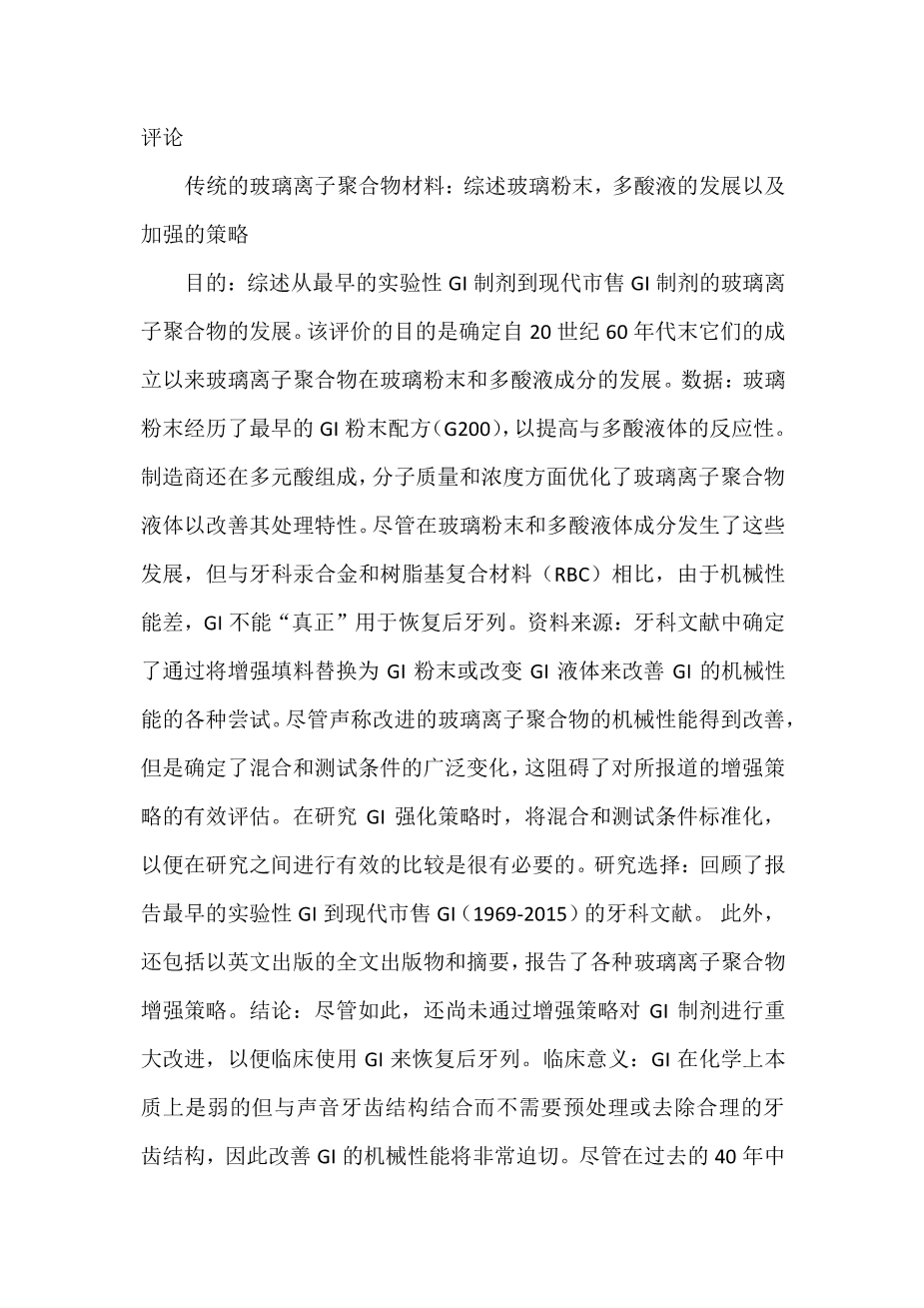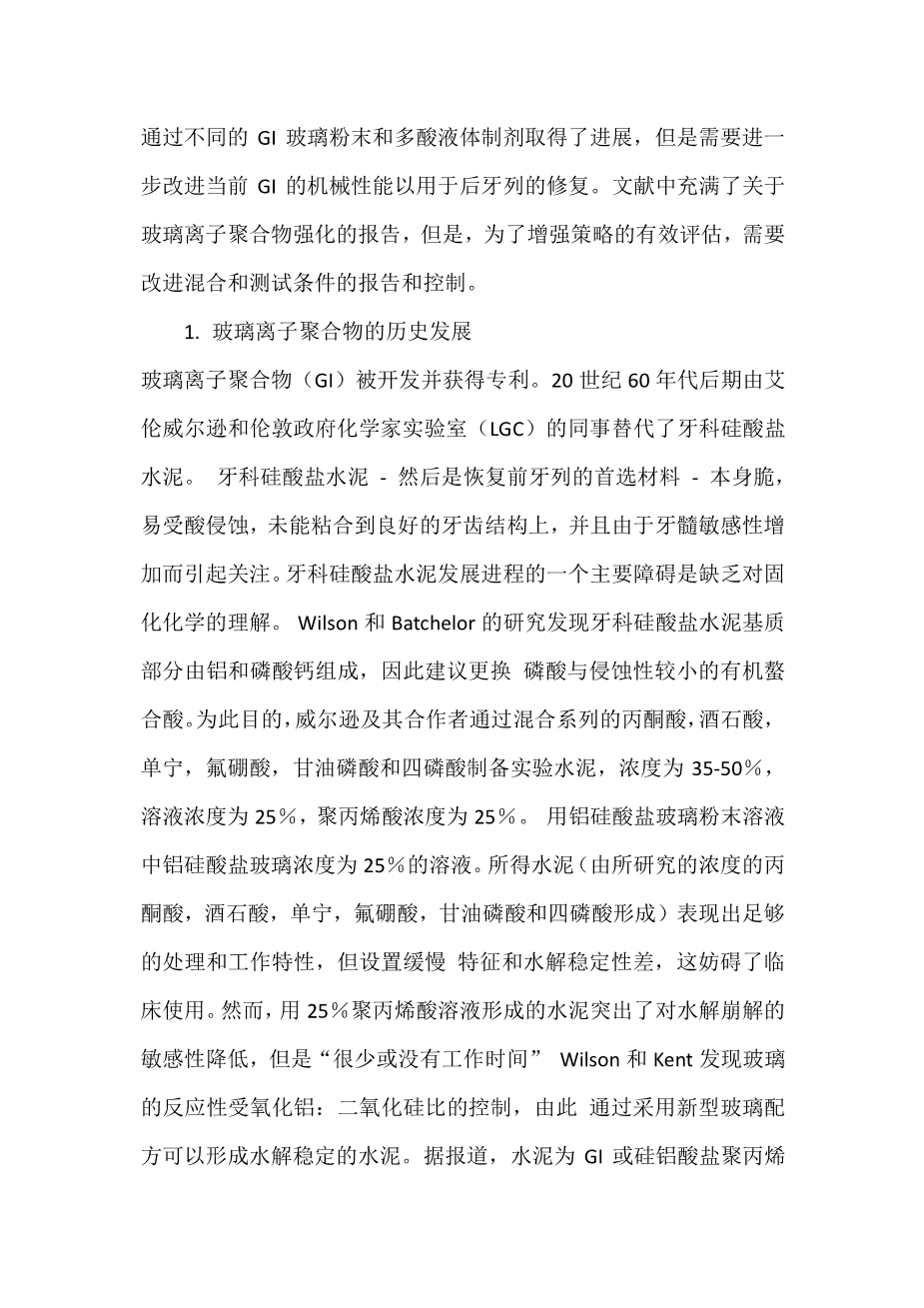Review
Conventional glass-ionomer materials: A review of the developments in glass powder, polyacid liquid and the strategies of reinforcement
Objectives: The development of glass-ionomers (GIs) from the earliest experimental GI formulations to the modern day commercially available GIs was reviewed. The aim of the review was to identify the developments in the glass powder and polyacid liquid constituents of GIs since their inception in the late 1960s. Data: The glass powder has undergone major changes from the earliest GI powder formulation (G200) in an effort to enhance the reactivity with the polyacid liquid. The GI liquids have also been optimised by the manufacturers in terms of polyacid composition, molecular weight and concentration to improve the handling characteristics. Despite these developments in the glass powder and polyacid liquid constituents, GIs cannot lsquo;trulyrsquo; be advocated for the restoration of posterior dentition due to the poor mechanical properties when compared with dental amalgam and resinbased composites (RBCs). Sources: Various attempts to improve the mechanical properties of GIs through substitution of reinforcing fillers to the GI powder or modification of the GI liquid were identified in the dental literature. Despite the claimed improvements in mechanical properties of the modified GIs, a wide variation in mixing and testing conditions was identified which prevented a valid assessment ofthe reported reinforcement strategies. When investigating a GI reinforcement strategy it is crucial that the mixing and testing conditions are standardised to allow a valid comparison between studies. Study selection: The dental literature reporting the earliest experimental GIs to modern day commercially available GIs (1969–2015) was reviewed. In addition, full-text publications and abstracts published in English reporting various GI reinforcement strategies were included. Conclusion: Nevertheless, major improvements in GI formulations through a reinforcement strategy have yet to be made to enable clinical usage of GIs for the restoration of posterior dentition. Clinical Significance: GIs chemically are inherently weak but bond to sound tooth structure without the need for preconditioning or removal of sound tooth structure such that improvements in the mechanical properties of GIs would be desirable. Although advances have been made through different GI glass powder and polyacid liquid formulations over the past 40 years, further improvements in the mechanical properties of the current GIs are required to be indicated for the restoration of posterior dentition. The literature is replete with reports on GI reinforcement, however, improved reporting and control of mixing and testing conditions are required for a valid assessment of the reinforcement strategies.
- Historical development of glass-ionomers
Glass-ionomers (GIs) were developed and patented in the late 1960s by Alan Wilson and co-workers at the Laboratory of the Government Chemist (LGC) in London to replace dental silicate cements. Dental silicate cements – then the primary material of choice for the restoration of anterior dentition – were inherently brittle, susceptible to acid erosion, failed to adhesively bond to sound tooth structure and raised concerns owing to increased pulpal sensitivity. A major impediment to the developmental progress of dental silicate cements was the lack of understanding of the setting chemistry. The discovery by Wilson and Batchelor that the dental silicate cement matrix was partially composed of aluminium and calcium phosphates led to the suggestion to replace phosphoric acid with a less aggressive organic chelating acid. For this purpose, experimental cements were prepared by Wilson and co-workers by mixing series of pyruvic, tartaric, tannic, fluoroboric, glycerophosphoric and tetraphosphoric acids, at concentrations of 35–50% in solution and polyacrylic acid at a concentration of 25% in solution with the aluminosilicate glass powder. The resultant cements (formed from pyruvic, tartaric, tannic, fluoroboric, glycerophosphoric and tetraphosphoric acids in the concentrations investigated) demonstrated adequate handling and working characteristics but slow setting characteristics and poor hydrolytic stability which precluded clinical usage. However, the cement formed with the 25% polyacrylic acid solution6 highlighted a reduced susceptibility to hydrolytic disintegration but had lsquo;little or no working timersquo;. Wilson and Kent discovered that the reactivity of the glass was controlled by the alumina:silica ratio, whereby hydrolytically stable cements could be formed by employing novel glass formulations. The early cements formed from modified alumina:silica ratio glass formulations also had poor working and setting characteristics and it was not until the 200th glass composition (G-200) – which was high in fluoride and calcium – that a usable dental cement was formed. The cement was reported as a GI or aluminosilicate polyacrylate (ASPA) cement. Despite the heightened anticipation for the clinical success of GIs, the first practical cement (ASPA-I) failed to impress John McLean, the clinical consultant who raised concerns regarding the poor setting characteristics and limited working time. Delayed hardening of the earliest GIs exposed them to the deleterious effects of moisture contamination during clinical placement9 and desiccation during the early stages of the setting reaction. In an attempt to improve the setting characteristics of GIs, Wilson et al. investigated the role of a third component, a chelating agent, in the setting reaction using citric acid, salicyclic acid, acetylone, sequestric acid, polyglycol and tartaric acid. The results for tartaric acid were promising and proved to be lsquo;effective beyond all expectationsrsquo;. Tartaric acid lengthened the working time, shortened the setting time, increased the compressive fracture strength (CFS) a
全文共21237字,剩余内容已隐藏,支付完成后下载完整资料


英语原文共 9 页,剩余内容已隐藏,支付完成后下载完整资料
资料编号:[2484]
您可能感兴趣的文章
- 复杂热电材料外文翻译资料
- 以自蔓延高温烧结方法制备热电化合物以及燃烧合成的新标准外文翻译资料
- 氮掺杂分级多孔碳作为氧还原反应的高效电化学催化剂的研究外文翻译资料
- 孪晶诱导塑性高嫡合金的设计外文翻译资料
- 含铌先进Fe-Cr-Ni型奥氏体耐热钢富铜相的析出强化在超临界电厂的应用外文翻译资料
- 不同温度下直接能量沉积层状工具钢的弯曲强度外文翻译资料
- BiFeO3的光伏效应外文翻译资料
- 通过氢稳定的MgaPt研究核壳纳米结构Mg@Pt中快速“氢泵”的可视化外文翻译资料
- 一种铱核心环金属有机配体显著地提高了有机太阳能电池 的光伏性能外文翻译资料
- 钠离子电池的高性能阳极材料:三组分共组装法制备层次多孔碳外文翻译资料


